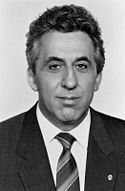President of East Germany
| Leadership of East Germany | |
|---|---|

|
|
| Residence |
Schoenhausen Palace Majakowskiring Waldsiedlung |
| Formation | 7 October 1949 |
| First holder |
|
| Final holder |
|
| Abolished |
|
The political leadership of East Germany was in the hands of several offices.
Prior the proclamation of an East German state, the Soviets established in 1948 the German Economic Commission (DWK) as a de facto government in their occupation zone. Its chairman was Heinrich Rau.
On 7 October 1949 an East German state, called the German Democratic Republic (GDR), was proclaimed and took the governmental functions over from the DWK. (Largely with the same function owners.)
For most of its existence (until autumn of 1989), the most important position in the GDR was that of the General Secretary of the Socialist Unity Party (SED) (titled as the First Secretary between 1953–1976). The Communist party and its leader held ultimate power and authority over state and government.
The formal head of state originally was the President of the German Democratic Republic. After the death of incumbent Wilhelm Pieck in 1960, the office was replaced by a collective head of state, the State Council. The position of chairman was commonly held by the party leader.
Government was headed by the Council of Ministers and its chairman, sometimes colloquially called Prime Minister.
Other important institutions included the People's Chamber, whose sessions were chaired by a President of the People's Chamber, and, since 1960, the National Defense Council, which held supreme command of the GDR's armed forces and had unlimited authority over the State in time of war. The Council was composed exclusively of members of the SED's Central Committee and Politburo, with the party leader serving as Chairman of the National Defense Council.
...
Wikipedia

